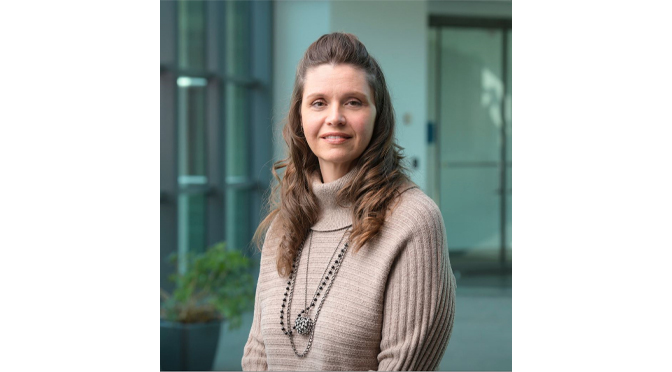When Tina Bollinger of Slatington decided to have her blood drawn as part of St. Luke’s community health research program DNA Answers, she mentally prepared herself for what she might find out.
Even so, the test results took the 49-year-old St. Luke’s Physician’s Group director by surprise.
“I was flagged for a BRCA1 gene mutation, putting me at a high risk for breast and GYN [ovarian] cancer,” she said. Though not the news she wanted to hear, she said she is grateful to have been made aware.
In December, St. Luke’s launched the community health research study, DNA Answers, in partnership with Helix, a California-based leading population genomics company. One of the goals of this joint initiative is to offer, at no cost to the participants, the opportunity to participate in research and have access to the latest screening techniques that support what is referred to as precision medicine.
“Through insights gleaned from patients’ unique genetic make-up, precision medicine enables ‘individually tailored’ health care – from early disease diagnosis to individualized treatment,” said St. Luke’s Senior Vice President of Clinical Integration, Dr. Aldo Carmona.
The initial goal of DNA Answers is to enroll 100,000 participants over four years.
“The individuals who participate in the research study will be provided, at no cost, with important health information about their potential risks for serious health conditions such as a certain type of cardiovascular disease and different types of cancer,” explained Dr. Christopher Chapman, the Principal Investigator for DNA Answers, who also serves as Chairman of the Department of Pathology and Laboratory Medicine and Medical Director for Precision Medicine at St. Luke’s.
With this knowledge, patients such as Bollinger are empowered to make proactive decisions with their healthcare providers to potentially delay or even prevent related disease and illness from occurring later in life.
“According to the National Comprehensive Cancer Network® (NCCN®), it is estimated that women with a BRCA1 mutation have a 60-72% lifetime risk for breast cancer,” explained Corrine Fillman, a St. Luke’s Genetic Counselor. “Women also have a 39-58% lifetime risk for ovarian cancer, while both women and men have an equal to or less than 5% lifetime risk for pancreatic cancer (NCCN, 2024). Additionally, men have an increased risk for prostate and male breast cancer (NCCN, 2024).”
Upon learning her test results, Bollinger spoke with Fillman, a genetic counselor on St. Luke’s Precision Medicine Team. During this appointment, they reviewed the cancer risks, screening and medical management recommendations associated with a BRCA1 mutation. Together, they developed a plan for Bollinger and referred her to the appropriate specialists to discuss breast cancer surveillance and preventive surgery.
“She was very good at explaining the many details of the results, which could be overwhelming,” Bollinger said of her genetic counselor.
NCCN Clinical Practice Guidelines in Oncology (NCCN Guidelines®) provides screening and medical management options for individuals with BRCA1 mutations. For breast cancer screening, such individuals may begin screening at the age of 25 with an annual breast MRI (NCCN Guidelines®, 2024). Starting at the age of 30, individuals may have both a mammogram and MRI annually (NCCN Guidelines, 2024). Women may also elect to have their ovaries and fallopian tubes removed before developing cancer (NCCN Guidelines, 2024).
Although her family has a history of breast cancer, Bollinger’s mammograms have always been negative, and her Pap smears and gynecologic exams normal. After consulting with a gynecologic oncologist, however, she has decided to undergo a risk-reducing surgery to remove her ovaries and fallopian tubes. Studies estimate that this surgical procedure will reduce the possibility of developing ovarian or fallopian tube cancer by over 80% (Finch et al., 2014).
Additionally, Bollinger’s plan to prevent breast cancer includes having regular “watchful waiting” breast ultrasounds or breast MRIs, alternating every six months to monitor her breast health. Should there be abnormal findings in either diagnostic test, she and her health care provider will explore further treatment options.
Identifying a BRCA1 mutation can be helpful for family members, as well. Bollinger and her genetic counselor discussed the 50% chance that first-degree relatives (parents, siblings, and children) inherit this mutation. Her daughter, age 30, and son, age 24, may also seek genetic testing to learn their risk.
Bollinger said that she is sharing her story to encourage her family, coworkers, and others throughout the community to enroll in DNA Answers as “an ounce of prevention,” and that she is thankful St. Luke’s has made this program available at no cost to participants.
“I absolutely have no regrets that I got tested, and I hope people across the Lehigh Valley and in New Jersey will take advantage of this service that will save lives.”
References
Finch, A. P., Lubinski, J., Møller, P., Singer, C. F., Karlan, B., Senter, L., Rosen, B., Meehle, L., Ghadirian, P., Cybulski, C., Huzarski, T., Eisen, A., Foulkes, W., Kim-Sing, C., Tung, N., Lynch, H., Neuhausen, S., Metcalfe, K. … & Narod, S. A. (2014). Impact of oophorectomy on cancer incidence and mortality in women with a BRCA1 or BRCA2 mutation. Journal of Clinical Oncology, 32(15), 1547-1553.
Referenced with permission from the NCCN Clinical Practice Guidelines in Oncology (NCCN Guidelines®) for Guideline Genetic/Familial High-Risk Assessment: Breast, Ovarian, and Pancreatic V1.2025. © National Comprehensive Cancer Network, Inc. 2024. All rights reserved. Accessed [September 20, 2024]. To view the most recent and complete version of the guideline, go online to NCCN.org.
NCCN makes no warranties of any kind whatsoever regarding their content, use or application and disclaims any responsibility for their application or use in any way.
About St. Luke’s
Founded in 1872, St. Luke’s University Health Network (SLUHN) is a fully integrated, regional, non-profit network of more than 20,000 employees providing services at 15 campuses and 350+ outpatient sites. With annual net revenue of $3.4 billion, the Network’s service area includes 11 counties in two states: Lehigh, Northampton, Berks, Bucks, Carbon, Montgomery, Monroe, Schuylkill and Luzerne counties in Pennsylvania and Warren and Hunterdon counties in New Jersey. St. Luke’s hospitals operate the largest network of trauma centers in Pennsylvania, with the Bethlehem Campus being home to St. Luke’s Children’s Hospital.
Dedicated to advancing medical education, St. Luke’s is the preeminent teaching hospital in central-eastern Pennsylvania. In partnership with Temple University, the Network established the Lehigh Valley’s first and only four-year medical school campus. It also operates the nation’s oldest School of Nursing, established in 1884, and 52 fully accredited graduate medical educational programs with more than 500 residents and fellows. In 2022, St. Luke’s, a member of the Children’s Hospital Association, opened the Lehigh Valley’s first and only free-standing facility dedicated entirely to kids.
SLUHN is the only Lehigh Valley-based health care system to earn Medicare’s five-star ratings (the highest) for quality, efficiency and patient satisfaction. It is both a Leapfrog Group and Healthgrades Top Hospital and a Newsweek World’s Best Hospital. The Network’s flagship University Hospital has earned the 100 Top Major Teaching Hospital designation from Fortune/PINC AI 10 years in a row, including in 2023 when it was identified as THE #4 TEACHING HOSPITAL IN THE COUNTRY. In 2021, St. Luke’s was identified as one of the 15 Top Health Systems nationally. Utilizing the Epic electronic medical record (EMR) system for both inpatient and outpatient services, the Network is a multi-year recipient of the Most Wired award recognizing the breadth of the SLUHN’s information technology applications such as telehealth, online scheduling and online pricing information. The Network is also recognized as one of the state’s lowest-cost providers.
Information provided to TVL by:
Sam Kennedy





